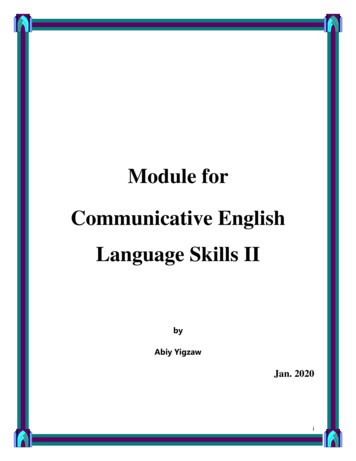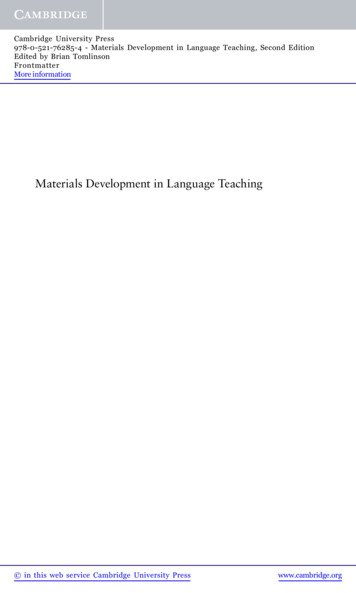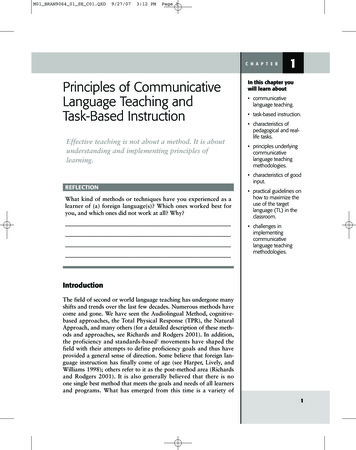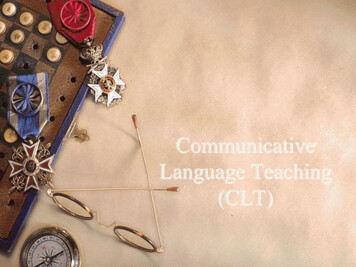
Transcription
Module forCommunicative EnglishLanguage Skills IIbyAbiy YigzawJan. 2020i
Introduction to the ModuleCommunicative English Language Skills II Module is a continuation of Communicative EnglishI Module, and it mainly aims to provide first year University students proficiency with reading,speaking and writing skills. It also aims to help students learn vocabularies that are assumedunfamiliar to them. In the grammar part, with the intention of providing explanations, brief notesare given in each unit.The module consists of five units with three supplementary reading at the end of the Module.The supplementary readings are included to support ideas included in the reading passages inunits 1-3.Students are advised to read the references put in the box for further learn the grammar pointsincluded in the Module.ReferencesAzar, B. S. (2003). Fundamentals of English grammar. Longman.Eggenschwiler, J.,& Biggs, E.D. (2001). Writing: Grammar, Usage, and Style. New York.Hungry Minds. IncLucy, J. A., & Lucy, L. A. (Eds.). (1993). Reflexive Language: Reported Speech andMeta pragmatics. Cambridge University Press.Murphy, R. (2012). English Grammar in Use. Ernst Klett Sprachen.Naylor, H., & Murphy, R. (2007). Essential Grammar in Use. Supplementary Exercises. WithAnswers. Ernst Klett Sprachenii
Table of ContentsPageUnit I : Life Skills1Part IReading passage: The concept of life skills2Part IIGrammar: Active and passive voices11Part IIISpeaking16Part IVWriting18Unit II: Speculations about the future of Science19Part IReading passage: Grassroots attack in bilharzia20Part IIGrammar: Future Tense26Part IIISpeaking33Part IVWriting33Unit III: Environmental protectionPart I35Reading: Environmental Challenges: A river runthrough it36Part IIGrammar: Modal verbs42Part IIISpeaking46Part IVWriting47Unit IV: Indigenous Knowledge48Part IReading: A local Pathway to Global Development49Part IIGrammar: Reported Speech54Part IIISpeaking59iii
Part IVWritingUnit V: Cultural HeritagePart I5960Reading: Cultural HeritageWhat is it? Why is it important61Part IIGrammar: Relative Clauses64Part IIISpeaking69Part IVWriting69Supplementary Readings70A. Environmental Problems71B. The Origin of Humans: The Record From the Afar of Ethiopia75C. Tourism Can be Used to Preserve Ethiopia’s Culturaland Historic Wealth84iv
Communicative English Language Skills II FINAL
Unit ILIFE SKILLSIntroductionIn this Unit, you will read a passage on ‘Life Skills’. You will discuss what life skills incorporateand the importance of learning them with your partners. Understanding the concept, you willengage in activities that help you develop your speaking, reading and writing abilities. Besides,you will consolidate the note-making skill you have been introduced in ‘Communication SkillsI’.The grammar lesson focuses on ‘Active’ and ‘Passive’ voices. I hope you adequately know aboutthem, but at this level we will briefly review what they are and you will focus much on applyingthem in oral and written reports. The knowledge of the active and passive voices helps you topresent oral report and write academic reports such as lab reports. As Natural Science students,for instance, you do experiments and your experimental reports require the use of passive voicesin most cases. So, the study helps you to use accurate language forms in your reports. SocialScience students also need the study of the voices to write good reports.Unit ObjectivesStudents are expected to: identify different components of ‘life skills’ so that they can actively apply them in life; become successful in living a community successfully and endeavor to execute skills tosolve problems that may occur in their community; develop their speaking, listening, reading and writing abilities in different areas including‘life skills’; and know the ‘voices’ in grammar and apply them in academic writing to enhance theirwriting and reporting quality.1
The first part of the Unit is a reading passage on ‘Life Skills’. Answer the following leadquestions before you read the passage.Activity 1.1: Discuss the following questions in groups before you read the passage below.1. What are life skills? ----------------------------------2. What are the basic elements of life skills? --------3. What is the importance of knowing about life skills? ---------------------------------------------4. Did you have life skills training? If you had, please share what you were trained aboutand how you were trained to your group. ---------------5. How did the training help you to manage your life? -----------------------------------------------THE CONCEPT OF LIFE SKILLSWhile many experts discuss the importance of life skills, many still question what exactlyrepresent such skills. As shall be shown, there is no single answer, but there are a variety ofoverlapping definitions, which highlight the most significant forms of life skills.Activity 1.2Instruction: The following questions are based on the paragraph you have justread. Before you read the succeeding paragraphs: a) Groupyourselves and discuss the questions with your group members; andb) write its summary in a very short sentence.1. What is the main idea of the paragraph? -----------------------------------2. What do you think the next paragraphs will be about? ---------------2
In practice, the term life skills is also used in several other ways, including to refer to livelihoodskills, such as how to set up a business; to refer to practical self-care skills such as how to planand prepare healthy meals or how to brush one’s teeth, etc.; to refer to skills used to deal withspecific risk situations, such as saying “no” in the face of peer pressure etc.The concept life skills involves personally responsible choices. These skills enable people tomaximize their own choices, to enhance their personal well-being and to improve their quality oflife. When people are being personally responsible they are in the process of making choices thatmaximize their happiness and fulfillment. Personal responsibility is a positive concept whereinpeople are responsible for their well-being and for making their own choices within the givens oftheir existence. Life skills therefore, are the component skills through which people assume –rather than avoid – personal responsibility for their lives. These skills enable people to makepositive contribution which can lead to improvement of their lives.Elias (1990) as mentioned by WHO (1994) notes that life skills are skills to carry out effectiveinterpersonal relationships and to make choices and resolve conflict without resorting to actionsthat will harm oneself or others. Adding to this, WHO (1994) further defines life skills as skillsthat enable individuals to deal effectively with the demands and challenges of everyday life. Thisgeneric type of skills includes decision-making, problem-solving, self-awareness andcommunication skills. TACADE (1990) views life skills as personal and social skills required byyoung people to function confidently and competently with themselves, with other people andwith the wider community.Peck and Hong (1988) cited in Tsatsi (2001) state that life skills are skills which enable people tocare for themselves in a supportive environment, and are concerned with independence in selfcare, understanding the environment and living with others. Skills also enable people to makedecisions concerning life situations. From a practical point of view Peck and Hong (1988) asmentioned by Tsatsi (2001) outlined the following life skills. Firstly personal skills, which referto those skills that are necessary to establish and maintain a network of appropriate andmeaningful relationships, interests and support systems e.g. developing friendships, leisureinterests, environmental and road safety, communication, social life, sexual relationships andmarriage. Personal skills are also of great importance for especially young people to fullyunderstand the influence of peer pressure. Secondly, home management skills, which include3
theoretical and technical knowledge necessary to live safely, comfortable and healthy. Skillssuch as budgeting, nutrition and hygiene may serve as examples. Thirdly, self-reliance skills,which include those skills, which are necessary for the individual to be able to organize his/ herown life and to maintain and utilize the resources, they need.The effective acquisition and application of life skills influence the way people feel aboutthemselves and others, and equally influence the way people are perceived by others. Accordingto WHO (1997) life skills contribute to peoples’ perceptions of self-efficacy, self-confidence andself-esteem. Life skills therefore, play an important role in the promotion of individuals’ mentalwell-being. The promotion of mental well-being contributes to people motivation to look afterthemselves and others, the prevention of mental disorders, and the prevention of health behaviorproblems. Life skills open doors and enable people to help themselves (Potgieter, 2004).Life skills are also framed as “abilities for adaptive and positive behavior that enable individualsto deal effectively with the demands and challenges of everyday life” (WHO, 1997). Describedin this way, skills that can be said to be life skills are innumerable and the nature and definitionof life skills are likely to differ across cultures and settings.However, analysis of the life skills field suggests that there is a core set of skills that are at theheart to skills-based initiatives for the promotion of the health and well-being of children andadolescents (Brack & Hill, 2000).In the context of this study life skills are self-helping skills that enable people to help themselves.As such they are aimed at empowering people. People who possess life skills are more adequateto fulfill their potential and meet their needs. Potgieter (2004) notes that a wide variety of skillscan be selected for inclusion in a life skills programme for adolescents. The selection dependslargely on the target condition, which the client system faces. For this study life skills includeacquisition of self-reliance skills such as decision-making, problem solving, critical thinking,self-awareness, assertiveness training, communication conflict resolution etc. A detaileddiscussion of these skills will follow later in this chapter.A final topic of interest in conceptualizing the concept life skills is the place of belonging indefining life skills. Both the WHO (1994) and American School Counseling Associations(ASCA, 1994) as mentioned by Anderson and Okoro (2000) imply that all life skills no matter at4
what level or dimension, must include the ability to facilitate a sense of belonging. Belongingplays a key role in the growth and development of self-esteem, social skills and initiative whilecreating a sense of belonging does not mean being a “buddy” and always getting along, it doesmean that a person is always welcomed into a group as long as they do not try to harm or disruptthe group. It also means that assertive communication and truth exist. It includes a sense ofsafety, both physical and emotional (Brack and Hill, 2000; Anderson & Okoro, 2000).Activity 1.3.Instruction: The following questions are based on the paragraphs you haveread above. Before you proceed reading the passage, do thefollowing activity in your group.1. Did you find that your prediction was right after you have read theabove paragraphs? ----------------------2. Discuss the concept of ‘life skills’ in your group based on yourreadings above. 3. Write the summary of the concept of ‘life skills’ in a very shortparagraph cooperatively. -----------------------------------The need for belonging is also emphasized by Alfred Adler (1870-1937) as cited by Brack andHill (2000: 24) who concluded that, as part of human nature there is a strong innate potential forkinship and belonging to the human race. Each person is born with a natural desire to belong to agroup, such as family or culture, and to contribute to the growth and well-being of that group. Itis a genetic need or genetic potential and it simply exists in everyone at birth. As noted above, aninnate or genetic potential is a potential capability, which is likely to be developed if a person isgiven the right opportunities. Without the right opportunities this need can be distorted ordestroyed (Baron & Byrne, 2003; Brack & Hill, 2000).5
According to Brack and Hill (2000) what is important to note here is that belonging, the ability topursue meaningful relationships and contribute to society, is not automatic, it needs to beconsciously developed and when it is developed, it is intrinsically rewarding. However, peoplehave to actually learn ways of trusting others, giving and accepting care and being sincere. Adler(1870-1937) as cited by the above-mentioned authors, states that learning these skills isintrinsically rewarding because the skills fulfill a genetic potential. Furthermore, because thisneed is rooted in a strong genetic potential the fulfillment of the need for belonging is also aprerequisite for emotional well-being. When the need for belonging is not met, a person mayeasily become aloof, manipulative and self-centered. When the feeling of belonging andinterpersonal connectedness develops, a sense of social interest, co-operation and equalityemerges. Belonging is met by obtaining results, which provides closer relationships with others,and competence is met by obtaining results, which are useful in many ways.Basically belonging consists of forming a bond with other individuals. Belonging is a socialcomponent of normal human development. It allows a person to express his or her social interestin a healthy and mutually reciprocal manner that builds upon strength of all group members./Activity 1.4. Write a brief conclusion to the above ------------------Activity 1.5:Instruction: Answer the following questions in groups based on the information in the passage.1. What are the values of interpersonal relationships? -----6
2. How do personal life skills help young people to understand the effect of peer pressure? --------3. How is the sense of belonging developed? -------------------What is its importance? : Write ‘true’ if the statement is correct and ‘false’ if the statement is incorrectaccording to the passage.1.Life skills lead to dependency on others because interpersonal communication promotesdependency on others.2.Life skills are hardly important for people to develop interpersonal skills because theylead people more to develop personally responsible choices.3.According to the information in the passage, one who is good at life skills is effective inorganizing and leading his life.4.Innate or genetic potential cannot develop after birth.5.The fulfillment of emotional well-being is a pre-requisite to belonging.Instruction: Choose the most appropriate alternative based on the information in the passage.1. Making personally responsible choices includes all except one.a)Maximizing choices to improve one’s life.b)Avoiding personal responsibility.c)Taking responsibility for one’s well-being.d)Making choices for enabling one’s happiness.2. One of the following is an example of home-management skills.a) Developing friendshipc) Marriageb) Road safetyd) Budgeting7
3. What will happen when the need for belonging is not fulfilled? A person may bea) assertivec) self-centeredb) happyd) communicative4. Potgieter (2004) mentions that life skills include the skill of:a)decision-makingc ) creating conflicta)critical thinkingd) A&B4. According to the American School Counseling Associations (ASCA, 1994), all life skillsmust incorporate the ability to enhance:a) A sense of belongingb) A feeling of responsibilityc) Critical thinkingd) empowering people5. As stated by Brack and Hill (2000), what kind of ability will be intrinsically motivated ifit is well developed?a) Problem solvingc) Pursuing meaningful rapportb) Assertived)Decision makingInstruction: According to the passage, what do the following words/pronouns refer to?1. ‘these’ (paragraph 3, line 1)2. ‘they’ (paragraph 3, line 3)3. ‘those’ (paragraph 5 line 6)4. ‘their’ (paragraph 9, line 3)5. ‘this’ (paragraph 11, line 7)6. ‘it’ ( paragraph 13, line 2)Instruction: Guess the meanings of the following words as they are used in the readingpassage.1. well-being (Para 3, line 5)2. self-awareness (Para 4, line 5)3. peer pressure (Para 5, line 10)4. self-efficacy (Para 6, line 3)5. self-esteem (Para 6, line 7)8
6. framed (Para 7, line 1)7. innumerable (Para 7, line 3)8. core (Para 8, line 1)9. kinship (Para 11, line 3)10. pursue (Para 12, line 2)NoteTypes of Conclusions Essay conclusions are, as a rule, no more than one paragraph inlength. To have a lengthier conclusion is to introduce a new topic or bring in too muchinformation to neatly wrap up the essay. Many students are under the impression that theconclusion should be a summary of the essay, touching on all the points as a reminder tothe reader. While this may be true in some disciplines (especially, within the socialsciences), it is not the most creative or interesting way to conclude an essay for yourEnglish class. Instead, consider one of the following possibilities as you write yourconcluding paragraph.The Embedded ConclusionIn some cases, especially with a narrative essay that tells a personal story inchronological order, the conclusion can be the last paragraph of the body. For instance, ifyou are telling the story of how you learned the English language, and the last paragraphbrings us to your current state of increased confidence mixed with lingering cautiousness,then that last paragraph gives us a solid place to part company.Example:I am now studying English in an ESL class at Cabrillo College. I know this is not the lastleg of my journey, for I have a lot more to learn about American idioms and phrasing.However, even as I struggle, I feel more confidence than ever before. I am so far getting“A” grades on all my written assignments. Still, I will always feel cautious, like I amwalking on egg shells, as I try to use a language that is so different from the one I wasborn into in a land faraway.9
The Retrospective ConclusionFor a narrative essay, or for any essay that uses chronology or traces an historicmovement, you may want to consider the retrospective conclusion. This concludingparagraph uses “hindsight” to consider what came before with new insight gained fromexperience.Example:Ten years ago, I would never have believed that I would be living in the United Statesand using English to buy groceries and make new friends. I would have fainted at thethought of writing professional documents in the English language. Nonetheless, here Iam, writing an English essay in my first college English class and expecting to receive an“A.” Time will tell how far my English studies will take me.The Reflective ConclusionThe reflective conclusion is similar to the retrospective kind, but it allows a broader trainof thought as one considers the various themes, lessons, or insights that have emergedfrom the essay writing experience.Example:In choosing to approach life’s challenges from a passive position, many teens see theirbad choices as a result of their circumstances. Whether it’s an unwanted pregnancy, adrug addiction, or an abusive relationship, girls especially can make excuses so that theydon’t have to change. I wish I could tell them that they don’t have to be imprisoned bytheir past choices—it’s never too late to take charge of your destiny.The Projective ConclusionThis type of conclusion works especially well for research papers but can be used formost expository essays and some narrative ones as well. It involves projecting a futureoutcome of the circumstances you describe. It may project the negative results of a socialissue if it remains unresolved or a threat to humanity. In other contexts, this conclusion10
can state a need for further research in an area to enhance our understanding, or it couldpredict an interesting, unexpected outcome based on current trends.Example:A crisis continues to brew in our school systems where it is no longer the case of justbullies turning to serial violence. As we saw in the Columbine shootings, even victims ofchronic bullying, in an attempt to fight back and regain some power or dignity, aretaking up arms and gunning down their classmates. Case after case shows us thatcriminal violence amongst school-aged children in America is not limited to just males orpinned to any one ethnicity or socioeconomic class. It is a crisis of the generation gapincreased by rapidly changing technology and a lack of real communication. Unless westart talking to each other, more of our youth will die, and children will be safer on thestreets than they are in the schoolyard.The above four types of conclusions are not meant to limit you but to give you guidanceas you apply your own unique stamp of creativity to your essay. The most importantfactor in writing your conclusion is that you give yourself enough time to experimentwith a few possibilities. Don’t deny yourself the creative thrill of that final flourish!Part IIGrammar: Active and Passive VoicesThe grammar lesson for the Unit is ‘Active and Passive Voices’. What are active and passivevoices? Can you give us examples? Read an article below and underline the verbs in the passivevoice.11
Active and Passive VoicesActivity 1.6: Identifying passive verb forms.Instruction: Read the following magazine article. Pay special attention to verbs in the passivevoice and underline them.The Academy Awards are given out every year to recognize outstanding work of movie actors,directors, and others who are part of the movie-making industry. These awards, called Oscars,are presented in a formal ceremony in Hollywood. Several people are nominated in specificcategories, such as Best Movie, Best Actor, Best Music, and Best Costumes. One nominee ischosen to receive an award in each category. When the awards ceremony started in 1929, 15awards were presented and the ceremony was attended by only 250 people. Tickets cost 10, andanyone who could afford a ticket could attend. Today about two dozen Oscars are presented.Tickets are no longer sold to the general public; invitations are sent only to people involved inmaking the movies and to their guests. Today the awards are presented in the 3400-seat KodakTheatre in Hollywood. Until 1941, the winners’ names were already known before the ceremonyand published in newspapers the night before the ceremony. Now the winners’ names are placedin sealed envelopes and the envelopes are not opened until the night of the ceremony. Since1953, Oscar night has been televised and broadcast all over the world. This show is seen byhundreds of millions of people. Viewers watch as their favorite movie stars arrive lookingbeautiful and hopeful.Activity 1.7.Instruction: In your group list down the verbs in passive voice below.1. ------------------------------8. ----------------------------------2. ------------------------------9. -----------------------------------3. ------------------------------10. ---------------------------------4. ------------------------------11. ---------------------------------5. ------------------------------12. ---------------------------------6. ------------------------------13. ---------------------------------7. ------------------------------14. ---------------------------------12
Now, discuss in your group how the above verbs were formed.The Passive Voice: FormTo help you understand the passive and active voices, their forms in different tenses are brieflygiven to you in the following Table. The active verb forms of different tenses are given in italicsunder the ‘Active’ column, while their passive forms are provided under the ‘Passive’ column inbold and italics.Activity 1.8:Instruction: Answer the following questions.1. What did you notice in the passive forms? ------2. What are the changes made in each tense? -------3. What are the different changes made between the active and passive voices? ---------------4. What inclusions have you noticed? ---------------5. Tell your answers for questions 1-4 to your group members. If you find differencesbetween your answers, try to convince each other referring to the example active andpassive forms of different tenses in Table 1.1 below.Note: Reading the following Table, compare active voice and passive voice in differenttenses.Table 1.1:Active and Passive voices in different tensesTenseActivePassive Be Past ParticipleSimple Present.A committee chooses the winner.ThewinnerischosenbyacommitteePresent ContinuousThey are presenting an award now.An award is being presented now.FutureThey will pick the best movie. They The best movie will be picked. The13
are going to pick the best movie.best movie is going to be picked.Simple PastThey announced the winner’s name.The winner’s name was announced.Past ContinuousThey were interviewing the winners.Thewinnerswerebeinginterviewed.Present PerfectThey have chosen the best movie.The best movie has been chosen.ModalYou can see the movie on DVD.The movie can be seen on DVDActivity 1. 9:Instruction: Write the correct active or passive forms of the verbs in brackets and list them in thespaces provided below. Take care of the tense you use. Numbers 2, 8 and 12 aredone for you as an example.My sister and I -------- (1. grow up) and went to school in Jamaica. We were educated (2.educate) according to the British system. In 1997 we -------- (3. give) the opportunity to come tothe United States. We decided to finish high school before leaving our own country. We -------(4.concern) that the education in this country might not be as good as the one we had there, andwe wanted to improve our English too.My colleagues A, B, and I, ------------ (5. design) an experiment to test the impact on workerperceptions of well-being when domesticated cats ------------- (6. allow) to freely roam variouswork environments in which the subjects were normally employed. Three test environments ---------- (7. select) for our experiments: a law office, a laboratory in which experiments ----------- (8.perform) using laboratory rats, and an automobile assembly line. One-way mirrored glass panelswere installed (9.install) to allow video cameras to record the activity and researchers to observethe same and take notes. We secretly inserted observers directly into the work environment.These observers posed as outside contractors and ------------ (10. uniform) as maintenance andcleaning staff, coffee and water service vendors, and similar supporting personnel. The observers------------ (11. draw) from the students who had been matriculated (12. matriculate) into theexperim
Communicative English Language Skills II Module is a continuation of Communicative English I Module, and it mainly aims to provide first year University students proficiency with reading, speaking and writing skills. It also aims to help student










